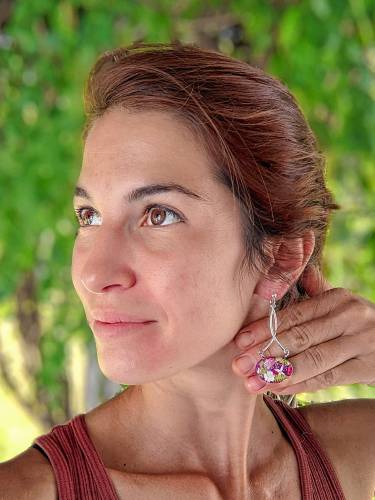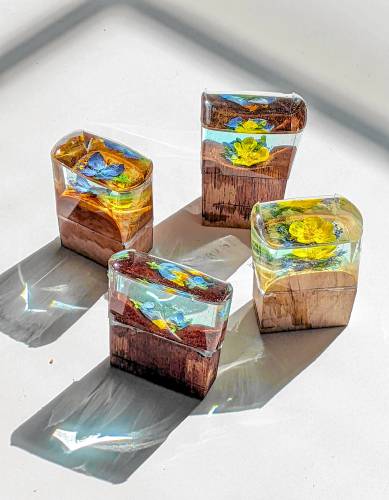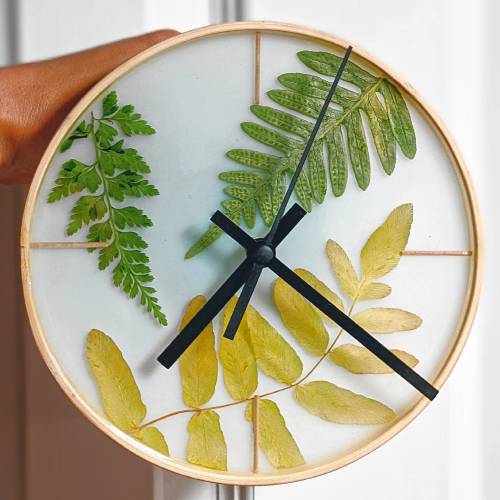A penchant for the tiny and beautiful: Camille Tahar creates art from nature’s smallest offerings
| Published: 10-16-2023 3:16 PM |
Camille Tahar is constantly on the lookout for the tiny and beautiful — especially when outdoors — and that penchant for wee gorgeousness inspires her to transform diminutive materials into works of art for people to wear, display, and use in the home.
Tahar grew up in southern France, where she was born, as well as in other places, including Germany and Italy. “We moved around a lot,” she said. “My father’s family is from Tunisia, and my relatives are scattered all around the planet. We’re a very multicultural bunch. On my mother’s side, though, we’ve been rooted in France for many generations.”
Tahar’s passport gained more destination stamps when she worked in the tourism industry and as a television reporter.
Despite her wide-ranging travels, she possesses a remarkable ability to focus deeply on one place, including miniscule portions of forest floor, field, or beach. “I love finding ferns, bits of shell, flower petals, and things like that.” Small wonders get Tahar’s creative juices flowing, leading her to preserve and enhance wild treasures.
Tahar began creating artwork from natural materials a few years ago, and she recently decided to go full-time with her own business, Pick Nature. She understands and works with plants’ ephemeral nature. “I’ve always loved plants,” said Tahar, “but once they’re picked, plants quickly become dry and brittle.” In 2017, she learned how to use resin to maintain plant materials in as close to their original state as possible. Information she found on the internet allowed her to immerse herself in a new hobby. “There are many different types of resin,” she said. “I’ve settled mostly on epoxy resin.”
When the pandemic brought tourism to a halt, the job Tahar had at the time shut down. The change allowed her to focus solely on her art, including working with resin. “Handling resin was much more difficult than I’d anticipated,” she said, but through trial and error, she learned the ropes. “It became my main occupation, even when I could work in tourism again. I also worked for a while at a local farm. But in March of this year, I decided to go full time with Pick Nature.”
Tahar has always been creative and hails from an artistic clan. “I was often short on money as a teen and young adult, so I made homemade holiday gifts when I could, like jewelry made of beads and wire.” Tahar also draws and paints, like others in her family. One sister illustrates children’s books; their mother is a watercolorist. “My other sister dreamed of being Indiana Jones, but that didn’t quite work out. Instead, she works as an archivist for the city of Lyon, classifying documents and going through medieval materials. But we’re all really creative.”
Tahar creates wearable art like necklaces, earrings, broaches, rings, hairclasps and bracelets. She also uses natural materials to transform keychains, kitchen utensils, clocks, platters, and other useful items. For home decor, she produces wreaths, decorative boxes, and an array of arrangements.
Article continues after...
Yesterday's Most Read Articles
 Ja’Duke eyes expansion to Greenfield
Ja’Duke eyes expansion to Greenfield
 My Turn: Quabbin region will never see any benefits from reservoir
My Turn: Quabbin region will never see any benefits from reservoir
 The cool new ‘underground’ spot in town: Le Peacock in Shelburne Falls delivers on colorful décor, people, food and cocktails
The cool new ‘underground’ spot in town: Le Peacock in Shelburne Falls delivers on colorful décor, people, food and cocktails
 Renovation of vacant Greenfield house will help those ‘priced out’ of home ownership
Renovation of vacant Greenfield house will help those ‘priced out’ of home ownership
 Attorney seeks dismissal of RI man’s DUI charges in Northfield crash that injured seven
Attorney seeks dismissal of RI man’s DUI charges in Northfield crash that injured seven
 As I See It: Between Israel and Palestine: Which side should we be on, and why?
As I See It: Between Israel and Palestine: Which side should we be on, and why?
“I love finding attractive, well-crafted wooden objects in thrift stores,” said Tahar. “I enjoy restoring and decorating them with flowers.” No matter the project, however, the first rule is that plants must be completely dried in order to preserve their shape. Tahar dries plants in several ways, including by simply air drying. “But it’s tricky in this region,” she said, “because we have high humidity all year round. And if dried plants re-humidify, they turn brown.”
Using a dehumidifier is key; Tahar keeps one going in her studio. Another strategy is to store dried plants with silica gel, a substance used by florists to dry flowers. “If you don’t want to press a flower — if you want to preserve the 3-D aspect — silica gel is great. You put the flower in the bottom of a container and cover it with the substance, which looks like white sand. It’s very absorbent, so shoe manufacturers include it with footwear that travels overseas by boat.”
Once the plant material is properly dried, Tahar brings resin into the process. “Casting in resin is the trickiest part,” she said, “because resin likes to create bubbles. Resin artists actually have nightmares about bubbles.” There are many techniques; for example, heat is important, but it’s also vital not to use too much. “This is the one phase of my work that I find stressful,” said Tahar. “Resin is difficult to master and humbling as a discipline. Over time, though, I’m getting better at it. And the results are worth it.”
Some resins have high VOC (volatile organic compounds) and are highly toxic. Tahar opts for brands with lower emissions. “Depending on the product, I might use more ventilation, and if the instructions recommend using a respirator or mask, I definitely wear one. But mostly, I use low VOC products.” Fortunately, her exposures to resin are short and limited, about once a week or every two weeks.
The environment in which resin work takes place must be as dust-free as possible, as well as controlled for temperature and humidity. “Around 65 to 70 degrees is ideal,” said Tahar. Once resin is poured and cured, there’s sanding and polishing to be done.
Tahar forages for material, or grows it herself. “It’s all local,” she said. “When I’m hiking, I can’t not pick things. I love finding mushrooms, acorns, flowers, leaves, and many species of ferns. I admit I’m addicted to ferns.”
Tahar looks for color: “All sorts of wildflowers, especially buttercups. They’re so vibrant!” She noted that since buttercups are considered invasive, “maybe by picking them, I’m doing a sort of favor. I try to educate myself about what’s invasive, as well as what’s endangered.”
Given the amount of time Tahar spends outdoors and her irresistible urges to collect, her studio is packed with materials. She collects mostly during the spring, summer and fall. “In the winter, there’s always winterberries, but during that season I spend more time creating, since my own garden has been put to bed.” Tahar sorts materials, then gets busy assembling. Next comes the resin, “coat after coat,” she said. “Putting layers upon layers is the best technique.”
If she has a custom order, Tahar sometimes completes an object in one day. “But if wood is involved,” she said, “it can be a multi-week process.” She enjoys working in her new studio: she and her husband, Andrew, are renovating a Shelburne home. “To do this work, you really need ample space and a home base,” said the world traveler who spent years on the road.
Her husband grew up in Belchertown, and Tahar “decided to settle in the States because of him.” The couple met while they were each traveling, and then explored the world together over many miles and regions. Later, they built a tiny home with the help of a friend. When tiny homes became popular, Tahar was intrigued, and she loved the one they created. “But realistically, it’s just not enough space for a working artist.”
Sometimes, when Tahar spots something in nature, she has an idea right away of what she’d like to make. Other times, she goes through her collections and arranges things in order to get ideas. “I also get ideas from customers who make special requests,” she said. “For example, someone recently asked me to make an anniversary ring, and they wanted it to include wood, and yellow and blue flowers. I got really inspired and ended up making four different rings for them to choose from.”
Tahar sells her artwork at the Greenfield Farmers Market and is exploring other regional markets and fairs. “But the Greenfield Farmers Market was my first one. I love the community there, so I’m keeping that as my main market.”
Readers can view Tahar’s work on Instagram at @_picknature.
Eveline MacDougall is the author of “Fiery Hope,” and an artist, musician and mom. You can reach her at eveline@amandlachorus.org.





 Speaking of Nature: Indulging in eye candy: Finally, after such a long wait, it’s beginning to look like spring is here
Speaking of Nature: Indulging in eye candy: Finally, after such a long wait, it’s beginning to look like spring is here Celebrating ‘Seasonings’: New book by veteran preacher and poet, Allen ‘Mick’ Comstock
Celebrating ‘Seasonings’: New book by veteran preacher and poet, Allen ‘Mick’ Comstock Faith Matters: How to still the muddy waters of overthinking: Clarity, peace and God can be found in the quiet spaces
Faith Matters: How to still the muddy waters of overthinking: Clarity, peace and God can be found in the quiet spaces A time for every purpose under heaven: Free sing-a-long Pete Seeger Fest returns to Ashfield, April 6
A time for every purpose under heaven: Free sing-a-long Pete Seeger Fest returns to Ashfield, April 6
